An official website of the United States government
 United States Department of Labor
United States Department of Labor
Operate and tend bridges, canal locks, and lighthouses to permit marine passage on inland waterways, near shores, and at danger points in waterway passages. May supervise such operations. Includes drawbridge operators, lock operators, and slip bridge operators.
Employment estimate and mean wage estimates for Bridge and Lock Tenders:
| Employment (1) | Employment RSE (3) |
Mean hourly wage |
Mean annual wage (2) |
Wage RSE (3) |
|---|---|---|---|---|
| 4,040 | 5.0 % | $ 21.52 | $ 44,760 | 1.6 % |
Percentile wage estimates for Bridge and Lock Tenders:
| Percentile | 10% | 25% | 50% (Median) |
75% | 90% |
|---|---|---|---|---|---|
| Hourly Wage | $ 13.18 | $ 13.80 | $ 21.82 | $ 28.49 | $ 30.93 |
| Annual Wage (2) | $ 27,400 | $ 28,690 | $ 45,390 | $ 59,250 | $ 64,330 |
Industries with the highest published employment and wages for Bridge and Lock Tenders are provided. For a list of all industries with employment in Bridge and Lock Tenders, see the Create Customized Tables function.
Industries with the highest levels of employment in Bridge and Lock Tenders:
| Industry | Employment (1) | Percent of industry employment | Hourly mean wage | Annual mean wage (2) |
|---|---|---|---|---|
| Federal Executive Branch (OEWS Designation) | 1,150 | 0.05 | $ 28.20 | $ 58,650 |
| Local Government, excluding schools and hospitals (OEWS Designation) | 660 | 0.01 | $ 21.53 | $ 44,770 |
| State Government, excluding schools and hospitals (OEWS Designation) | 620 | 0.03 | $ 20.14 | $ 41,890 |
| Other Heavy and Civil Engineering Construction | 60 | 0.05 | $ 25.74 | $ 53,540 |
Industries with the highest concentration of employment in Bridge and Lock Tenders:
| Industry | Employment (1) | Percent of industry employment | Hourly mean wage | Annual mean wage (2) |
|---|---|---|---|---|
| Other Heavy and Civil Engineering Construction | 60 | 0.05 | $ 25.74 | $ 53,540 |
| Federal Executive Branch (OEWS Designation) | 1,150 | 0.05 | $ 28.20 | $ 58,650 |
| State Government, excluding schools and hospitals (OEWS Designation) | 620 | 0.03 | $ 20.14 | $ 41,890 |
| Local Government, excluding schools and hospitals (OEWS Designation) | 660 | 0.01 | $ 21.53 | $ 44,770 |
Top paying industries for Bridge and Lock Tenders:
| Industry | Employment (1) | Percent of industry employment | Hourly mean wage | Annual mean wage (2) |
|---|---|---|---|---|
| Rail Transportation | (8) | (8) | $ 28.70 | $ 59,690 |
| Federal Executive Branch (OEWS Designation) | 1,150 | 0.05 | $ 28.20 | $ 58,650 |
| Other Heavy and Civil Engineering Construction | 60 | 0.05 | $ 25.74 | $ 53,540 |
| Local Government, excluding schools and hospitals (OEWS Designation) | 660 | 0.01 | $ 21.53 | $ 44,770 |
| State Government, excluding schools and hospitals (OEWS Designation) | 620 | 0.03 | $ 20.14 | $ 41,890 |
States and areas with the highest published employment, location quotients, and wages for Bridge and Lock Tenders are provided. For a list of all areas with employment in Bridge and Lock Tenders, see the Create Customized Tables function.
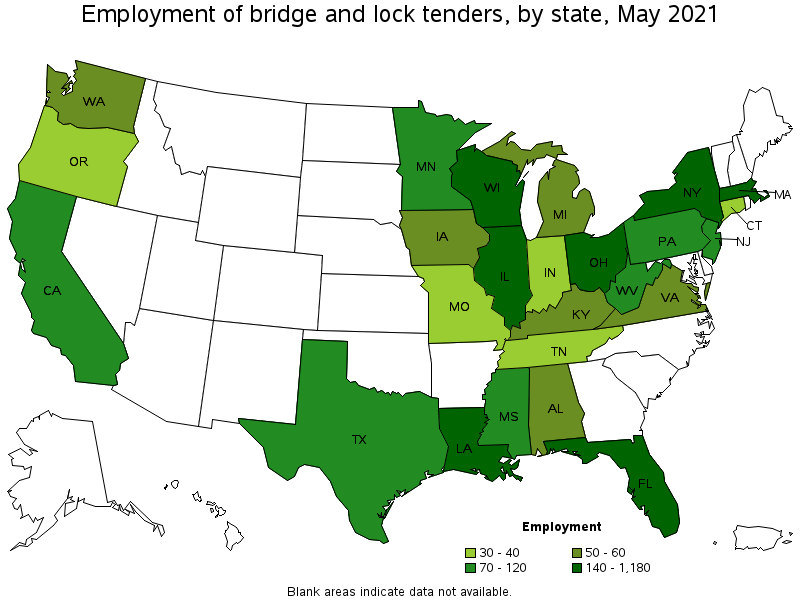
States with the highest employment level in Bridge and Lock Tenders:
| State | Employment (1) | Employment per thousand jobs | Location quotient (9) | Hourly mean wage | Annual mean wage (2) |
|---|---|---|---|---|---|
| Florida | 1,180 | 0.14 | 4.79 | $ 15.21 | $ 31,640 |
| Louisiana | 430 | 0.24 | 8.34 | $ 18.88 | $ 39,270 |
| Massachusetts | 290 | 0.09 | 3.02 | (8) | (8) |
| Illinois | 290 | 0.05 | 1.78 | $ 29.91 | $ 62,220 |
| New York | 220 | 0.02 | 0.87 | $ 21.79 | $ 45,310 |
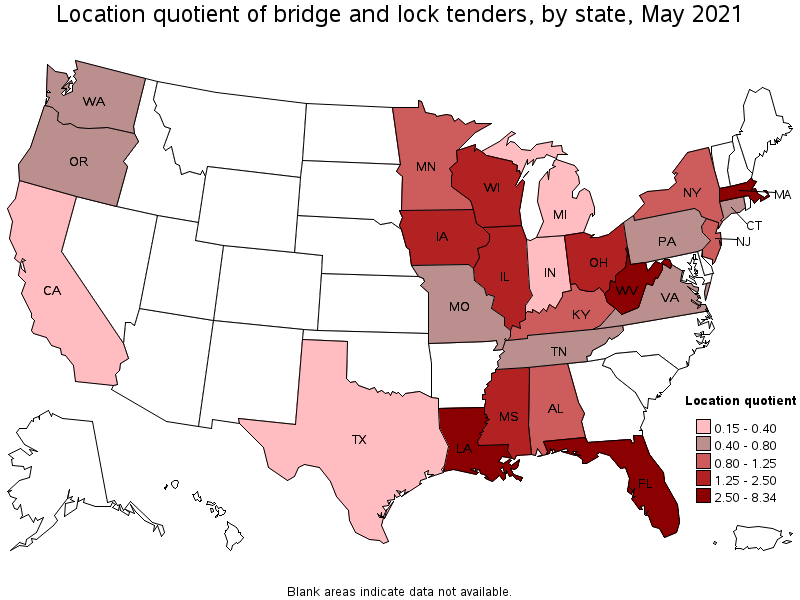
States with the highest concentration of jobs and location quotients in Bridge and Lock Tenders:
| State | Employment (1) | Employment per thousand jobs | Location quotient (9) | Hourly mean wage | Annual mean wage (2) |
|---|---|---|---|---|---|
| Louisiana | 430 | 0.24 | 8.34 | $ 18.88 | $ 39,270 |
| Florida | 1,180 | 0.14 | 4.79 | $ 15.21 | $ 31,640 |
| West Virginia | 70 | 0.11 | 3.76 | $ 27.87 | $ 57,960 |
| Massachusetts | 290 | 0.09 | 3.02 | (8) | (8) |
| Mississippi | 70 | 0.06 | 2.11 | $ 22.88 | $ 47,590 |
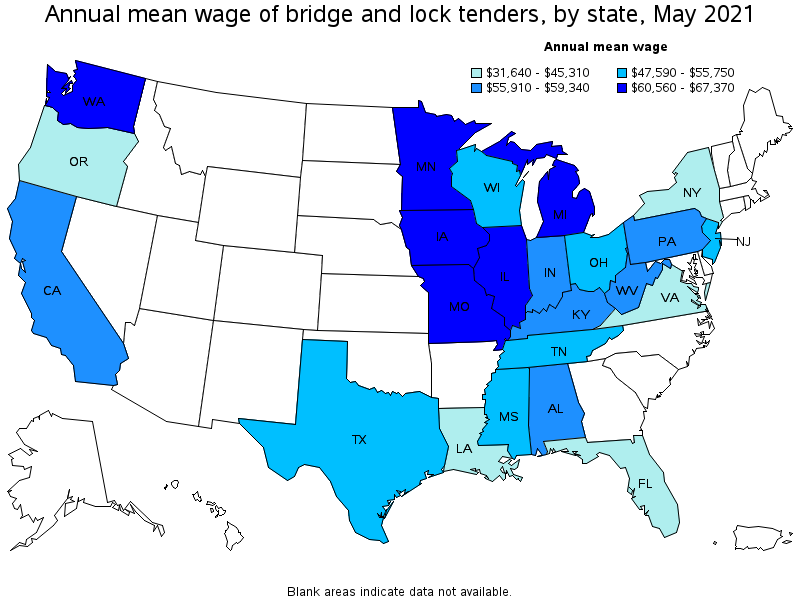
Top paying states for Bridge and Lock Tenders:
| State | Employment (1) | Employment per thousand jobs | Location quotient (9) | Hourly mean wage | Annual mean wage (2) |
|---|---|---|---|---|---|
| Washington | 60 | 0.02 | 0.65 | $ 32.39 | $ 67,370 |
| Minnesota | 70 | 0.03 | 0.94 | $ 30.41 | $ 63,250 |
| Illinois | 290 | 0.05 | 1.78 | $ 29.91 | $ 62,220 |
| Michigan | 50 | 0.01 | 0.39 | $ 29.28 | $ 60,900 |
| Missouri | 40 | 0.02 | 0.54 | $ 29.17 | $ 60,660 |
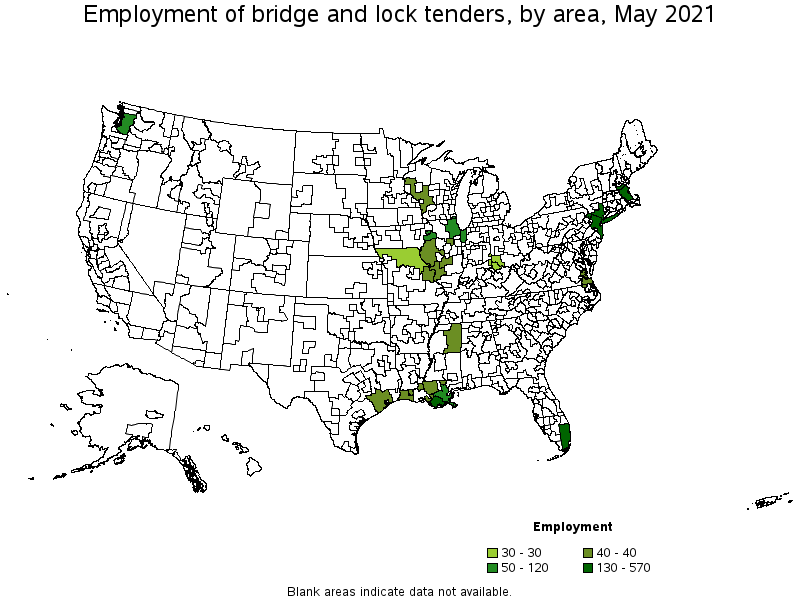
Metropolitan areas with the highest employment level in Bridge and Lock Tenders:
| Metropolitan area | Employment (1) | Employment per thousand jobs | Location quotient (9) | Hourly mean wage | Annual mean wage (2) |
|---|---|---|---|---|---|
| Miami-Fort Lauderdale-West Palm Beach, FL | 570 | 0.23 | 8.10 | $ 15.27 | $ 31,770 |
| Boston-Cambridge-Nashua, MA-NH | 220 | 0.09 | 2.99 | (8) | (8) |
| New York-Newark-Jersey City, NY-NJ-PA | 140 | 0.02 | 0.56 | $ 24.25 | $ 50,440 |
| Houma-Thibodaux, LA | 130 | 1.65 | 57.47 | $ 14.54 | $ 30,250 |
| Chicago-Naperville-Elgin, IL-IN-WI | 120 | 0.03 | 0.96 | $ 31.05 | $ 64,590 |
| New Orleans-Metairie, LA | 90 | 0.18 | 6.44 | $ 19.07 | $ 39,660 |
| Seattle-Tacoma-Bellevue, WA | 60 | 0.03 | 1.00 | $ 32.48 | $ 67,560 |
| Davenport-Moline-Rock Island, IA-IL | 50 | 0.28 | 9.76 | $ 28.16 | $ 58,580 |
| Virginia Beach-Norfolk-Newport News, VA-NC | 40 | 0.06 | 2.17 | $ 17.47 | $ 36,330 |
| Baton Rouge, LA | 40 | 0.11 | 3.99 | $ 19.38 | $ 40,300 |
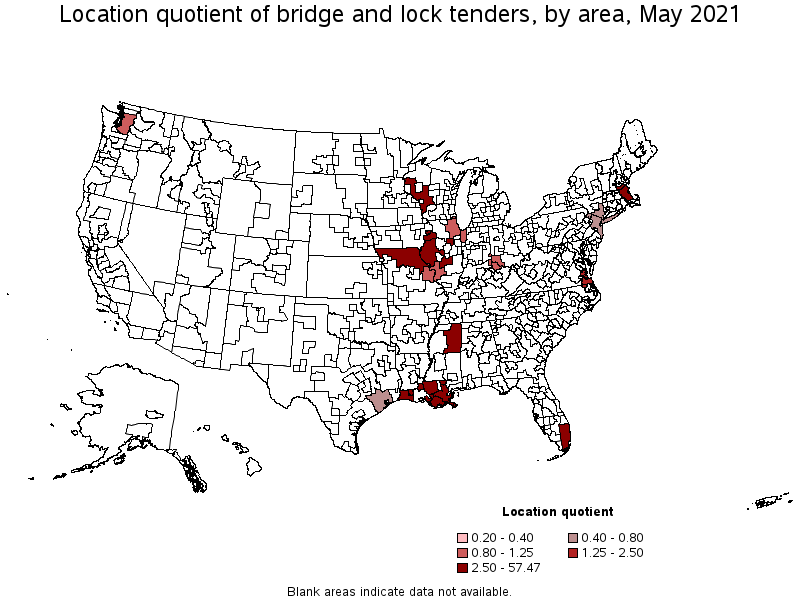
Metropolitan areas with the highest concentration of jobs and location quotients in Bridge and Lock Tenders:
| Metropolitan area | Employment (1) | Employment per thousand jobs | Location quotient (9) | Hourly mean wage | Annual mean wage (2) |
|---|---|---|---|---|---|
| Houma-Thibodaux, LA | 130 | 1.65 | 57.47 | $ 14.54 | $ 30,250 |
| Lake Charles, LA | 40 | 0.40 | 13.90 | $ 18.98 | $ 39,480 |
| Davenport-Moline-Rock Island, IA-IL | 50 | 0.28 | 9.76 | $ 28.16 | $ 58,580 |
| Miami-Fort Lauderdale-West Palm Beach, FL | 570 | 0.23 | 8.10 | $ 15.27 | $ 31,770 |
| New Orleans-Metairie, LA | 90 | 0.18 | 6.44 | $ 19.07 | $ 39,660 |
| Baton Rouge, LA | 40 | 0.11 | 3.99 | $ 19.38 | $ 40,300 |
| Boston-Cambridge-Nashua, MA-NH | 220 | 0.09 | 2.99 | (8) | (8) |
| Virginia Beach-Norfolk-Newport News, VA-NC | 40 | 0.06 | 2.17 | $ 17.47 | $ 36,330 |
| Cincinnati, OH-KY-IN | 30 | 0.03 | 1.16 | $ 25.56 | $ 53,160 |
| Seattle-Tacoma-Bellevue, WA | 60 | 0.03 | 1.00 | $ 32.48 | $ 67,560 |
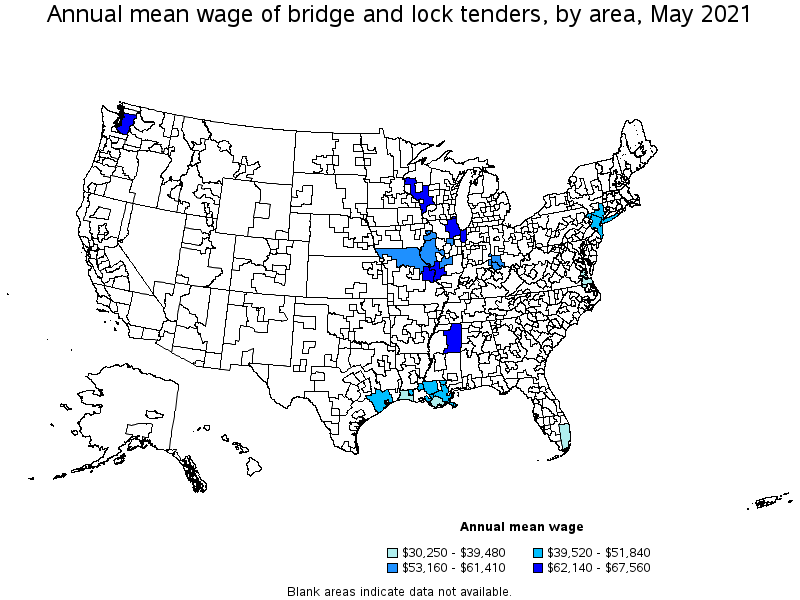
Top paying metropolitan areas for Bridge and Lock Tenders:
| Metropolitan area | Employment (1) | Employment per thousand jobs | Location quotient (9) | Hourly mean wage | Annual mean wage (2) |
|---|---|---|---|---|---|
| Seattle-Tacoma-Bellevue, WA | 60 | 0.03 | 1.00 | $ 32.48 | $ 67,560 |
| Chicago-Naperville-Elgin, IL-IN-WI | 120 | 0.03 | 0.96 | $ 31.05 | $ 64,590 |
| St. Louis, MO-IL | 40 | 0.03 | 0.96 | $ 29.88 | $ 62,140 |
| Davenport-Moline-Rock Island, IA-IL | 50 | 0.28 | 9.76 | $ 28.16 | $ 58,580 |
| Cincinnati, OH-KY-IN | 30 | 0.03 | 1.16 | $ 25.56 | $ 53,160 |
| Houston-The Woodlands-Sugar Land, TX | 40 | 0.01 | 0.47 | $ 24.93 | $ 51,840 |
| New York-Newark-Jersey City, NY-NJ-PA | 140 | 0.02 | 0.56 | $ 24.25 | $ 50,440 |
| Baton Rouge, LA | 40 | 0.11 | 3.99 | $ 19.38 | $ 40,300 |
| New Orleans-Metairie, LA | 90 | 0.18 | 6.44 | $ 19.07 | $ 39,660 |
| Lake Charles, LA | 40 | 0.40 | 13.90 | $ 18.98 | $ 39,480 |
Nonmetropolitan areas with the highest employment in Bridge and Lock Tenders:
| Nonmetropolitan area | Employment (1) | Employment per thousand jobs | Location quotient (9) | Hourly mean wage | Annual mean wage (2) |
|---|---|---|---|---|---|
| Southwest Louisiana nonmetropolitan area | 40 | 0.67 | 23.36 | $ 19.00 | $ 39,520 |
| Northeast Mississippi nonmetropolitan area | 40 | 0.18 | 6.29 | $ 29.93 | $ 62,250 |
| Western Wisconsin nonmetropolitan area | 40 | 0.28 | 9.67 | $ 30.52 | $ 63,490 |
| West Central Illinois nonmetropolitan area | 40 | 0.22 | 7.71 | $ 29.52 | $ 61,410 |
| North Missouri nonmetropolitan area | 30 | 0.31 | 10.75 | $ 28.95 | $ 60,210 |
Nonmetropolitan areas with the highest concentration of jobs and location quotients in Bridge and Lock Tenders:
| Nonmetropolitan area | Employment (1) | Employment per thousand jobs | Location quotient (9) | Hourly mean wage | Annual mean wage (2) |
|---|---|---|---|---|---|
| Southwest Louisiana nonmetropolitan area | 40 | 0.67 | 23.36 | $ 19.00 | $ 39,520 |
| North Missouri nonmetropolitan area | 30 | 0.31 | 10.75 | $ 28.95 | $ 60,210 |
| Western Wisconsin nonmetropolitan area | 40 | 0.28 | 9.67 | $ 30.52 | $ 63,490 |
| West Central Illinois nonmetropolitan area | 40 | 0.22 | 7.71 | $ 29.52 | $ 61,410 |
| Northeast Mississippi nonmetropolitan area | 40 | 0.18 | 6.29 | $ 29.93 | $ 62,250 |
Top paying nonmetropolitan areas for Bridge and Lock Tenders:
| Nonmetropolitan area | Employment (1) | Employment per thousand jobs | Location quotient (9) | Hourly mean wage | Annual mean wage (2) |
|---|---|---|---|---|---|
| Western Wisconsin nonmetropolitan area | 40 | 0.28 | 9.67 | $ 30.52 | $ 63,490 |
| Northeast Mississippi nonmetropolitan area | 40 | 0.18 | 6.29 | $ 29.93 | $ 62,250 |
| West Central Illinois nonmetropolitan area | 40 | 0.22 | 7.71 | $ 29.52 | $ 61,410 |
| North Missouri nonmetropolitan area | 30 | 0.31 | 10.75 | $ 28.95 | $ 60,210 |
| Southwest Louisiana nonmetropolitan area | 40 | 0.67 | 23.36 | $ 19.00 | $ 39,520 |
These estimates are calculated with data collected from employers in all industry sectors, all metropolitan and nonmetropolitan areas, and all states and the District of Columbia. The top employment and wage figures are provided above. The complete list is available in the downloadable XLS files.
The percentile wage estimate is the value of a wage below which a certain percent of workers fall. The median wage is the 50th percentile wage estimate—50 percent of workers earn less than the median and 50 percent of workers earn more than the median. More about percentile wages.
(1) Estimates for detailed occupations do not sum to the totals because the totals include occupations not shown separately. Estimates do not include self-employed workers.
(2) Annual wages have been calculated by multiplying the hourly mean wage by a "year-round, full-time" hours figure of 2,080 hours; for those occupations where there is not an hourly wage published, the annual wage has been directly calculated from the reported survey data.
(3) The relative standard error (RSE) is a measure of the reliability of a survey statistic. The smaller the relative standard error, the more precise the estimate.
(8) Estimate not released.
(9) The location quotient is the ratio of the area concentration of occupational employment to the national average concentration. A location quotient greater than one indicates the occupation has a higher share of employment than average, and a location quotient less than one indicates the occupation is less prevalent in the area than average.
Other OEWS estimates and related information:
May 2021 National Occupational Employment and Wage Estimates
May 2021 State Occupational Employment and Wage Estimates
May 2021 Metropolitan and Nonmetropolitan Area Occupational Employment and Wage Estimates
May 2021 National Industry-Specific Occupational Employment and Wage Estimates
Last Modified Date: March 31, 2022